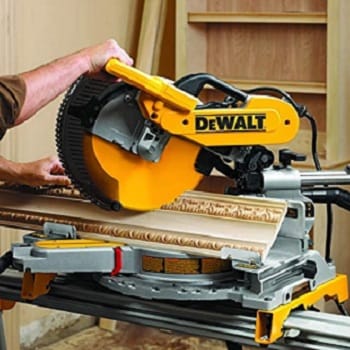As an Amazon Associate, I earn from qualifying purchases.

Coving is a decorative material used to add character to ceilings and walls. Cutting coving can be a challenging task, but with the right tools and techniques, anyone can do it. In this article, we will be discussing how to cut coving with a mitre saw.
What is Coving?
Coving, also known as cornicing, is a decorative material that is used to add a finishing touch to the top edges of walls and ceilings. It is commonly made from plaster, although it can also be made from other materials such as polystyrene or PVC. The purpose of coving is to provide a smooth transition between the wall and ceiling and to add character and depth to the room.
Tools Required for Cutting Coving
Before we begin discussing how to cut coving with a mitre saw, let’s take a look at the tools required for this task:
- Mitre saw
- Coving measuring tool
- Coving adhesive
- Pencil
- Safety glasses
- Dust mask
How To Cut Coving With A Mitre Saw?

Once you have all the necessary tools, it’s time to start cutting coving with a mitre saw. Here are some useful tips to keep in mind:
1. Measure Twice, Cut Once
Before cutting the coving, it’s important to make sure that you have measured the length and angle correctly. Use a coving measuring tool to ensure that you have the exact measurements and angle required.
2. Adjust the Mitre Saw
Once you have the correct measurements, adjust the mitre saw to the required angle. Set the blade to a 45-degree angle for standard coving and adjust accordingly for more complex angles.
3. Cut the Coving
Place the coving onto the saw bed and hold it securely in place. Starting with one end, carefully guide the coving through the saw blade. Remember to wear safety glasses and a dust mask to protect your eyes and lungs from any debris.
4. Join the Coving
Once you have cut the coving, use coving adhesive to join the separate pieces together. Apply a small amount of adhesive to the joining surfaces and press the pieces together firmly.
Common Questions About Cutting Coving With A Mitre Saw

Now that we have covered the basics of cutting coving with a mitre saw, here are some common questions that people often ask:
How do I cut complex angles?
To cut complex angles, you will need to adjust the mitre saw accordingly. Start by making a rough cut and then refine the angle by making small adjustments until you have the exact angle required.
Can I cut coving without a mitre saw?
It is possible to cut coving without a mitre saw, but it is more difficult and time-consuming. You can use a coping saw or a handsaw, but the cuts may not be as precise.
Can I paint coving after cutting?
Yes, it is possible to paint coving after cutting. Use a good quality paint that is suitable for the material of the coving.
The benefits of cutting coving with a mitre saw
A mitre saw is a specialized tool that is used to make accurate cuts at a variety of angles. When cutting coving, a mitre saw can be used to create clean, sharp cuts that will create a professional looking finish.
There are a few benefits to using a mitre saw when cutting coving.
- First, it is a very precise tool which means that you can get clean, sharp cuts that will create a neat finish.
- Secondly, it is a quick and easy way to cut coving, which means that you can save time and effort when completing a project.
If you are planning on cutting coving, then a mitre saw is definitely the best tool for the job. With its precision and speed, you can create a professional looking finish with ease.
The best way to cut coving with a mitre saw
To cut coving with a mitre saw, first set the saw to the correct angle. Next, use a tape measure to mark the cutting line on the coving. Then, cut along the line with the saw, making sure to keep the blade straight. Finally, use a sanding block to smooth the edges of the coving.
Tips for cutting coving with a mitre saw
Coving is a decorative molding that is installed around the perimeter of a room, where the walls and ceiling meet. It can be made from a variety of materials, including wood, plaster, and plastic.
Cutting coving with a mitre saw is a relatively simple task, but there are a few things to keep in mind to ensure a clean, precise cut.
- First, be sure to measure the wall and ceiling accurately so that you know exactly where to make your cuts.
- Second, use a sharp blade on your mitre saw – a dull blade will make it more difficult to get a clean, precise cut.
- Finally, take your time and be careful when making your cuts – rushing can lead to mistakes.
With these tips in mind, cutting coving with a mitre saw should be a relatively simple and straightforward task. Just be sure to take your time, use a sharp blade, and measure accurately before making your cuts.
Conclusion
Cutting coving with a mitre saw may seem like a daunting task at first, but with the right tools and techniques, anyone can do it. Remember to measure twice, cut once, and wear safety gear to protect yourself from any debris. With these tips in mind, you’ll be able to add character and depth to your walls and ceilings with ease.





